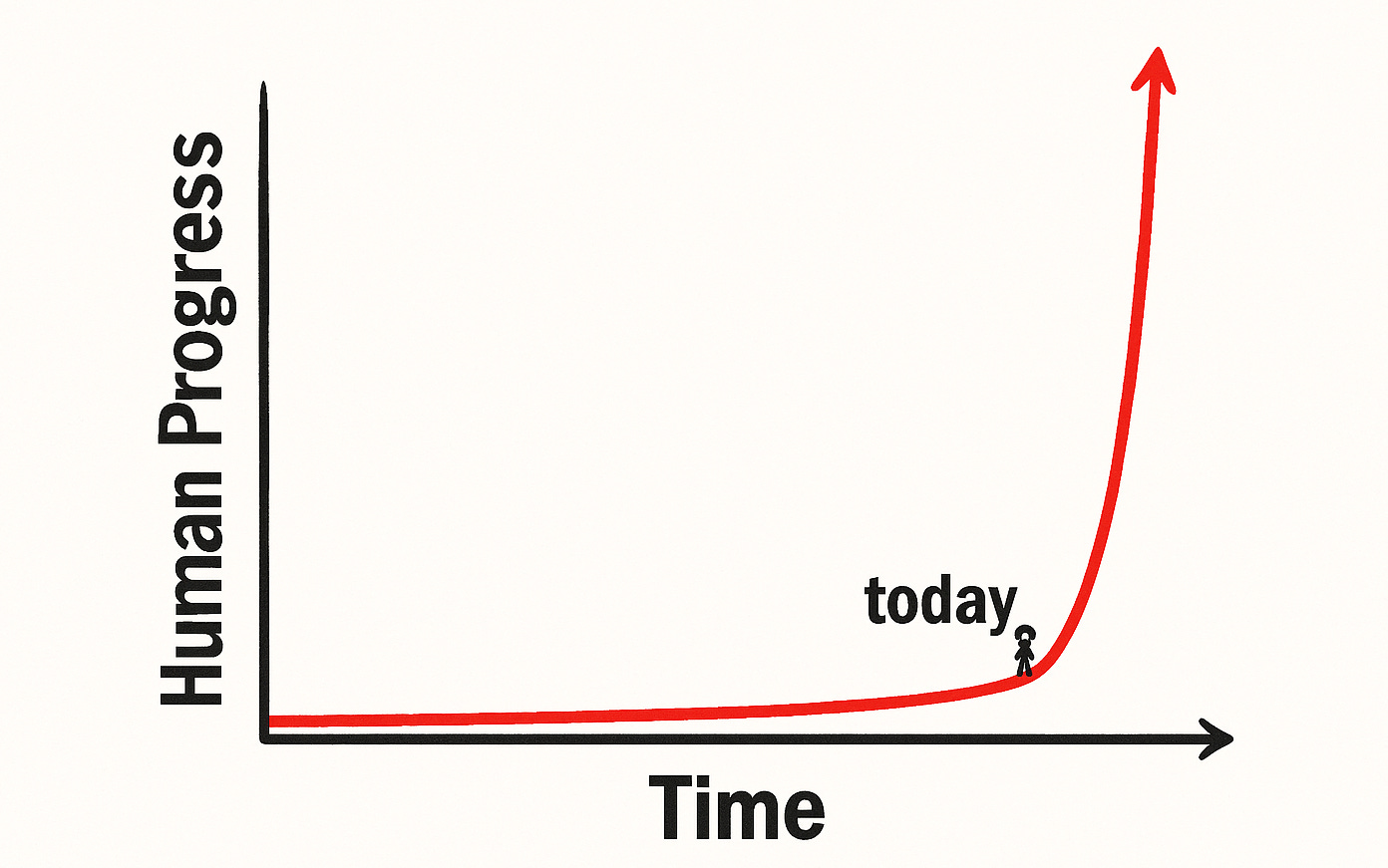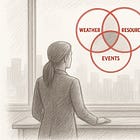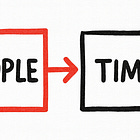AI-enabled Evolution, Katrina 20 Years On, Humans in the Loop, & More
Profiles in Preparedness #38
Image adapted and re-created from Wait But Why.
We rarely notice when the ground beneath us is shifting. Progress feels steady and predictable—until the curve we’re walking suddenly bends upward.
That’s what makes it so difficult to tell whether today’s AI advances are simply an evolution in how we work, or the first signs of a revolution.
AI is already changing preparedness in tangible ways. Work that once required teams and weeks of effort can now be done by one person in an afternoon. We can draw from larger data sets to build risk profiles, cut superfluous content from otherwise actionable plans, design engaging training programs in less time, and evaluate performance after exercises or real events in ways not previously possible. In our Situation Reports, we continually test ways for AI to sharpen real-time awareness of emerging threats.
Yet we shouldn’t mistake these gains for a revolution. At least not yet.
AI has transformed tasks, but it hasn’t transformed the job. We are still approaching the way we prepare to respond to and recover from disasters in the same fundamental way. The system itself—the assessments, plans, exercises, structures, processes, and decision-making models that define disaster management—hasn't changed. What AI has given us is an extraordinary evolution: faster, leaner, more efficient work in an environment of tight budgets and limited staff.
But I do believe the revolution is coming. At some point, the very system by which we ensure life safety, stabilize incidents, and protect property will be re-engineered. Will that inflection point be a decade away or arrive tomorrow? Who knows. But we may not recognize it until it’s already here. When it does, leaders locked into long-term commitments with legacy platforms may look like laggards—or like visionaries if the S-curve of progress takes longer to turn upward.
That is the challenge of preparedness strategy today. Your bid for success must account for both slopes: the evolution we’re living through today and the revolution that will eventually reshape the system.
Many of the articles we read this week were focused on this exact topic, with the top three included below. We hope you enjoy.
Inside The CP Journal
Here are some of the articles that were added to the site this week. And don’t forget, our U.S. and Front Range (Colorado) Situation Reports are available to all subscribers and come out each Wednesday.
In this article, we highlight why recognizing when threats and hazards converge is a uniquely human task, and often a responsibility of executives.
As AI becomes increasingly capable of providing situation updates, recognizing when conditions shift from being innocuous to dangerous requires a discipline that we describe in the article.
🔒For Academy subscribers, here is the next article in our Project Management in Emergency Management Playbook.
A budget isn’t just about dollars—it’s about how you plan to use the resources you have to accomplish your goals. It’s the bridge between your project’s purpose and its delivery.
This Week‘s Reads
Here are a few standout reads from this week with insights, ideas, and perspectives that caught my attention.
Article | The Drone and AI Delusion. The question of "evolution vs. revolution" in this week's opening came from this outstanding article explaining what defense venture capital firms get wrong about military evolutions and war. I read and re-read this article several times this week and strongly recommend it to hear a long-form argument for why "this techno-centric narrative overlooks a critical reality: that militaries do not win wars merely by acquiring new gadgets, but by developing the institutions, training regimens, logistical networks, and doctrinal concepts that enable those tools to be used effectively at scale." It is a concept that carries over from defense to our domestic readiness.
Article | The most 'AI-exposed' jobs keep winning: how quickly is AI really coming for your job? The focus on AI disrupting tasks and activities (rather than jobs and systems) in this week’s opening comes from an article in Consulting Intel newsletter, which is worth the read. Using the loom as an example, he shows how a machine, at first, replaced just an activity, but the role of the master weaver remained, since there was more to the job than pulling levers. Similar to the Drone article above, as MC writes, "Until you re-engineer the whole system, the job is stubbornly alive. The hard-to-automate layer is not the individual keystrokes or prompts, but the orchestration."
Article | The AI Revolution. In an article prophetically written in 2015, Tim Urban from Wait but Why does a great job showing how hard it is to predict revolutions and truly non-linear changes in human progress. When looking at the image at the top of this week's newsletter, remember that the little person on the line can't see to his/her right. They can only see where they've been, not what is coming. His narrative about what it would be like to be on this line (at the top of his article) is incredible and can be very helpful in realizing how hard it is to recognize the evolution turning into revolution.
Documentary Series | Hurricane Katrina: Race Against Time. As we near the 20th anniversary of Hurricane Katrina making landfall in Louisiana, I watched this 5-episode series this week and wholeheartedly recommend it. It’s one thing to read about the water; it’s another to see videos of it rushing past rooftops. It’s one thing to remember that the "Super Dome was crowded," and entirely another to see the pictures and videos of the masses of people outside the stadium. If you need a reminder of what happens when we fail to prepare and when leaders fail to get ready for disaster, this documentary does that and more, highlighting the conditions that led to nearly 1,400 people dying in the storm’s aftermath.
Enjoyed This Issue? Pass It On and Go Deeper.
If this newsletter sparked ideas or challenged your thinking, share it with your network, a colleague, or on social media. Sharing is how we expand the community of professionals committed to getting and staying left of bang.
And if you want to go further, become a paying subscriber for exclusive access to:
The Tactical Analysis Course & behavioral analysis practice exercises
The Project Management in Emergency Management Playbook
The Operational Readiness Playbook that details how to build a watch office
And if you’re thinking about how to strengthen your organization's preparedness, that’s what we do. Whether it’s strategy development, assessments, planning, speaking events, or exercises, we help teams build the skills and strategies to stay ahead of the next challenge.




